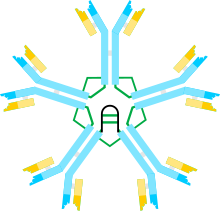IgM nephropathy
 From Wikipedia the free encyclopedia
From Wikipedia the free encyclopedia
| IgM nephropathy | |
|---|---|
| Other names | immunoglobulin M nephropathy (IgMN) |
 | |
| Antibody type IgM scheme. Blue - heavy chains, Yellow — light chains, Dark yellow/blue — variable regions (ends are binding sites), Light yellow/blue — constant regions, Green — disulfide bridges, Black — J chain | |
| Specialty | Nephrology |
IgM nephropathy or immunoglobulin M nephropathy (IgMN) is a kind of idiopathic glomerulonephritis that is marked by IgM diffuse deposits in the glomerular mesangium.[1] IgM nephropathy was initially documented in 1978 by two separate teams of researchers.[2]
Signs and symptoms[edit]
Young adults or children with IgM nephropathy typically exhibit proteinuria or hematuria. In people with IgMN, proteinuria can vary from nephrotic syndrome to asymptomatic proteinuria.[3]
Causes[edit]
The cause of IgM nephropathy is unknown.[citation needed] Several systemic illnesses, including paraproteinemia, diabetes mellitus, rheumatoid arthritis, systemic lupus erythematosus (SLE), and Alport's syndrome, can cause IgM deposits in the glomeruli.[4][5]
Mechanism[edit]
It is yet unknown how IgM nephropathy develops, however it has been proposed that aberrant T-cell activity or a disruption in mesangial cell immunoaggregate clearance may be involved.[6][7] Several investigations have found that patients with IgM nephropathy have higher blood IgM or IgM immunocomplex concentrations, which would provide support to the previously indicated idea.[8][9]
Diagnosis[edit]
Light microscopy (LM) on a renal sample reveals variable degrees of mesangial cell proliferation or mesangial sclerosis from minute alterations.[3][10] A small number of instances with crescentic glomerulonephritis (GN) have been documented.[11] Immunofluorescence (IF) analysis of kidney biopsy specimens shows that IgM deposits in the mesangium have a granular or diffuse appearance.[12] While there may be traces of other immunoglobulins besides IgM, significant IgM deposition is typically indicative.[3][10] Certain investigations have also revealed the existence of complement fragments, such as C3 or C1q.[3]
See also[edit]
References[edit]
- ^ Chae, Yura; Yoon, Hye Eun; Chang, Yoon Kyung; Kim, Young Soo; Kim, Hyung Wook; Choi, Bum Soon; Park, Cheol Whee; Song, Ho Cheol; Kim, Young Ok; Koh, Eun Sil; Chung, Sungjin (2021-09-16). "Renal Outcome of IgM Nephropathy: A Comparative Prospective Cohort Study". Journal of Clinical Medicine. 10 (18). MDPI AG: 4191. doi:10.3390/jcm10184191. ISSN 2077-0383. PMC 8466757. PMID 34575298.
- ^ Bhasin, H K; Abuelo, J G; Nayak, R; Esparza, A R (July 1978). "Mesangial proliferative glomerulonephritis". Laboratory Investigation; A Journal of Technical Methods and Pathology. 39 (1): 21–29. PMID 355724.
- ^ a b c d Connor, Thomas M.; Aiello, Valeria; Griffith, Megan; Cairns, Thomas; Roufosse, Candice A.; Cook, H. Terence; Pusey, Charles D. (2016-04-15). "The natural history of immunoglobulin M nephropathy in adults". Nephrology Dialysis Transplantation. 32 (5). Oxford University Press (OUP): 823–829. doi:10.1093/ndt/gfw063. hdl:10044/1/34185. ISSN 0931-0509. PMC 5837784. PMID 27190379.
- ^ Salmon, A. H. J.; Kamel, D.; Mathieson, P. W. (2004-09-23). "Recurrence of IgM nephropathy in a renal allograft". Nephrology Dialysis Transplantation. 19 (10). Oxford University Press (OUP): 2650–2652. doi:10.1093/ndt/gfh434. ISSN 0931-0509. PMID 15388823.
- ^ Mokhtar, Ghadeer A. (2011). "IgM Nephropathy: Clinical Picture and Pathological Findings in 36 Patients". Saudi Journal of Kidney Diseases and Transplantation. 22 (5): 969–975. ISSN 1319-2442. PMID 21912027. Retrieved 2024-02-24.
- ^ Cavallo, T.; Johnson, M.P. (1981). "Immunopathologic Study of Minimal Change Glomerular Disease with Mesangial IgM Deposits". Nephron. 27 (6). S. Karger AG: 281–284. doi:10.1159/000182071. ISSN 1660-8151. PMID 7266716.
- ^ Lin, Ching-Yuang; Chen, Chih-Hsin; Lee, Piau-Po (1989). "In vitro B-lymphocyte switch disturbance from IgM into IgG in IgM mesangial nephropathy". Pediatric Nephrology. 3 (3). Springer Science and Business Media LLC: 254–258. doi:10.1007/bf00858525. ISSN 0931-041X. PMID 2702103.
- ^ Helin, H.; Mustonen, J.; Pasternack, A.; Antonen, J. (1982). "IgM-Associated Glomerulonephritis". Nephron. 31 (1). S. Karger AG: 11–16. doi:10.1159/000182598. ISSN 1660-8151. PMID 7050751.
- ^ Disciullo, S O; Abuelo, J G; Moalli, K; Pezzullo, J C (1988). "Circulating heavy IgM in IgM nephropathy". Clinical and Experimental Immunology. 73 (3). Oxford University Press: 395–400. PMC 1541770. PMID 3145162.
- ^ a b Brugnano, R.; Del Sordo, R.; Covarelli, C.; Gnappi, E.; Pasquali, S. (2016-02-03). "IgM nephropathy: is it closer to minimal change disease or to focal segmental glomerulosclerosis?". Journal of Nephrology. 29 (4). Springer Science and Business Media LLC: 479–486. doi:10.1007/s40620-016-0269-6. ISSN 1121-8428. PMID 26842624.
- ^ Park, Kyoung Sook; Kang, Ea Wha; Kie, Jeong Hae (2019-08-27). "A case report of immunoglobulin M nephropathy manifesting as crescentic glomerulonephritis and nephrotic syndrome in an adult". BMC Nephrology. 20 (1). Springer Science and Business Media LLC: 335. doi:10.1186/s12882-019-1528-2. ISSN 1471-2369. PMC 6712640. PMID 31455257.
- ^ Myllymäki, Juhani; Saha, Heikki; Mustonen, Jukka; Helin, Heikki; Pasternack, Amos (2003). "IgM nephropathy: Clinical picture and long-term prognosis". American Journal of Kidney Diseases. 41 (2). Elsevier BV: 343–350. doi:10.1053/ajkd.2003.50042. ISSN 0272-6386. PMID 12552495.
Further reading[edit]
- Myllymäki, Juhani; Saha, Heikki; Mustonen, Jukka; Helin, Heikki; Pasternack, Amos (2003). "IgM nephropathy: Clinical picture and long-term prognosis". American Journal of Kidney Diseases. 41 (2). Elsevier BV: 343–350. doi:10.1053/ajkd.2003.50042. ISSN 0272-6386. PMID 12552495.